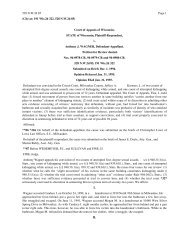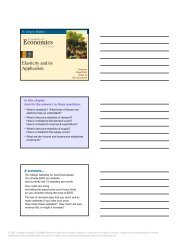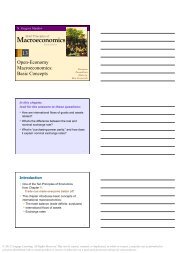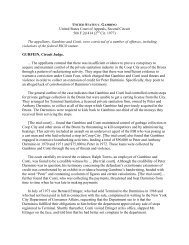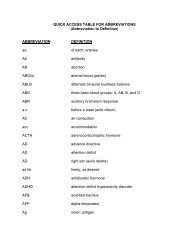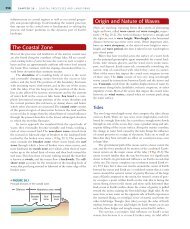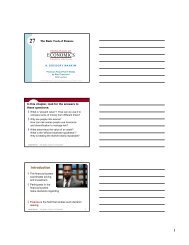Solving Linear Equations and Inequalities - Cengage Learning
Solving Linear Equations and Inequalities - Cengage Learning
Solving Linear Equations and Inequalities - Cengage Learning
Create successful ePaper yourself
Turn your PDF publications into a flip-book with our unique Google optimized e-Paper software.
Appendix D: <strong>Solving</strong> <strong>Linear</strong> <strong>Equations</strong><br />
<strong>and</strong> <strong>Inequalities</strong><br />
<strong>Linear</strong> <strong>Equations</strong><br />
A linear equation in one variable x is an equation that can be written in the st<strong>and</strong>ard<br />
form ax b 0, where a <strong>and</strong> b are real numbers with a 0.<br />
A linear equation in one variable, written in st<strong>and</strong>ard form, has exactly one<br />
solution. To see this, consider the following steps. (Remember that a 0.)<br />
ax b 0<br />
ax b<br />
x b<br />
a<br />
Original equation<br />
Subtract b from each side.<br />
Divide each side by a.<br />
To solve a linear equation in x, isolate x on one side of the equation by creating a<br />
sequence of equivalent (<strong>and</strong> usually simpler) equations, each having the same solution(s)<br />
as the original equation. The operations that yield equivalent equations come from the<br />
Substitution Principle <strong>and</strong> the Properties of Equality.<br />
Generating Equivalent <strong>Equations</strong><br />
An equation can be transformed into an equivalent equation by one or more of the<br />
following steps.<br />
Original Equivalent<br />
Equation Equation<br />
1. Remove symbols of grouping,<br />
combine like terms, or simplify<br />
fractions on one or both sides<br />
of the equation.<br />
2x x 4<br />
x 4<br />
2. Add (or subtract) the same<br />
quantity to (from) each side<br />
of the equation.<br />
x 1 6 x 5<br />
3. Multiply (or divide) each side<br />
of the equation by the same<br />
nonzero quantity.<br />
2x 6 x 3<br />
4. Interchange the two sides of<br />
the equation.<br />
2 x x 2<br />
After solving an equation, check each solution in the original equation. For example,<br />
you can check the solution to the equation in Step 2 above as follows.<br />
x 1 6<br />
5 1 <br />
6 6<br />
? 6<br />
Write original equation.<br />
Substitute 5 for x.<br />
Solution checks. ✓<br />
What you should learn<br />
● Solve linear equations in one<br />
variable.<br />
● Solve linear inequalities in one<br />
variable.<br />
Why you should learn it<br />
The method of solving linear<br />
equations is used to determine the<br />
intercepts of the graph of a linear<br />
function. The method of solving linear<br />
inequalities is used to determine the<br />
domains of different functions.<br />
D1
D2 Appendix D <strong>Solving</strong> <strong>Linear</strong> <strong>Equations</strong> <strong>and</strong> <strong>Inequalities</strong><br />
Example 1 <strong>Solving</strong> <strong>Linear</strong> <strong>Equations</strong><br />
a. 3x 6 0<br />
Original equation<br />
3x 6 6 0 6<br />
Add 6 to each side.<br />
3x 6<br />
Simplify.<br />
Divide each side by 3.<br />
Simplify.<br />
b. Original equation<br />
Distributive Property<br />
Subtract 12 from each side.<br />
Simplify.<br />
x Divide each side by 8 <strong>and</strong> simplify.<br />
Now try Exercise 17.<br />
3<br />
x 2<br />
42x 3 6<br />
8x 12 6<br />
8x 12 12 6 12<br />
8x 6<br />
4<br />
3x 6<br />
<br />
3 3<br />
<strong>Linear</strong> <strong>Inequalities</strong><br />
<strong>Solving</strong> a linear inequality in one variable is much like solving a linear equation in<br />
one variable. To solve the inequality, you isolate the variable on one side using<br />
transformations that produce equivalent inequalities, which have the same solution(s)<br />
as the original inequality.<br />
Generating Equivalent <strong>Inequalities</strong><br />
An inequality can be transformed into an equivalent inequality by one or more of<br />
the following steps.<br />
Original Equivalent<br />
Inequality Inequality<br />
1. Remove symbols of grouping,<br />
combine like terms, or simplify<br />
fractions on one or both sides<br />
of the inequality.<br />
4x x ≥ 2<br />
5x ≥ 2<br />
2. Add (or subtract) the same<br />
number to (from) each side<br />
of the inequality.<br />
x 3 < 5 x < 8<br />
3. Multiply (or divide) each side<br />
of the inequality by the same<br />
positive number.<br />
4. Multiply (or divide) each side<br />
of the inequality by the same<br />
negative number <strong>and</strong> reverse<br />
the inequality symbol.<br />
1<br />
2x > 3<br />
2x ≤ 6<br />
x > 6<br />
x ≥ 3
Example 2 <strong>Solving</strong> <strong>Linear</strong> <strong>Inequalities</strong><br />
a. x 5 ≥ 3<br />
Original inequality<br />
x 5 5 3 5 Subtract 5 from each side.<br />
x ≥ 2<br />
Simplify.<br />
The solution is all real numbers greater than or equal to 2, which is denoted by<br />
2, . Check several numbers that are greater than or equal to 2 in the original<br />
inequality.<br />
b. 4.2m > 6.3<br />
Original inequality<br />
Divide each side by 4.2 <strong>and</strong> reverse inequality symbol.<br />
m < 1.5<br />
Simplify.<br />
The solution is all real numbers less than 1.5, which is denoted by , 1.5.<br />
Check several numbers that are less than 1.5 in the original inequality.<br />
Now try Exercise 31.<br />
4.2m<br />
4.2 <<br />
6.3<br />
4.2<br />
Vocabulary <strong>and</strong> Concept Check<br />
In Exercises 1 <strong>and</strong> 2, fill in the blank.<br />
1. A _______ equation in one variable x is an equation that can be written in the<br />
st<strong>and</strong>ard form ax b 0.<br />
2. To solve a linear inequality, isolate the variable on one side using transformations<br />
that produce _______ .<br />
Procedures <strong>and</strong> Problem <strong>Solving</strong><br />
<strong>Solving</strong> <strong>Linear</strong> <strong>Equations</strong> In Exercises 3–24, solve the<br />
equation <strong>and</strong> check your solution.<br />
3. 4.<br />
5. 6.<br />
7. 8.<br />
9. 10.<br />
11. 12.<br />
13. 14.<br />
15. 16.<br />
17. 18.<br />
19.<br />
20.<br />
21.<br />
22.<br />
3<br />
2x <br />
23. 0.25x 0.7510 x 3<br />
24. 0.60x 0.40100 x 50<br />
1<br />
3<br />
2x 5 <br />
4x 2 10<br />
1<br />
x 11 15<br />
x 3 9<br />
x 2 5<br />
x 5 1<br />
3x 12<br />
2x 6<br />
x<br />
4<br />
5<br />
x<br />
5<br />
4<br />
8x 7 39<br />
12x 5 43<br />
24 7x 3<br />
13 6x 61<br />
8x 5 3x 20 7x 3 3x 17<br />
2x 5 10<br />
43 x 9<br />
2x 3 2x 2<br />
8x 2 42x 4<br />
4x 24 0<br />
Appendix D <strong>Solving</strong> <strong>Linear</strong> <strong>Equations</strong> <strong>and</strong> <strong>Inequalities</strong> D3<br />
D Exercises For instructions on how to use a graphing utility, see Appendix A.<br />
<strong>Solving</strong> <strong>Linear</strong> <strong>Inequalities</strong> In Exercises 25–46, solve<br />
the inequality <strong>and</strong> check your solution.<br />
25. x 6 < 8<br />
26. 3 x > 10<br />
27. x 8 > 17 28. 3 x < 19<br />
29. 6 x 8 30. x 10 6<br />
4<br />
Study Tip<br />
Remember that<br />
when you multiply or<br />
divide by a negative<br />
number, you must reverse the<br />
inequality symbol, as shown in<br />
Example 2(b).<br />
2<br />
3x < 4<br />
31. 32.<br />
33. 34.<br />
35. 36.<br />
37. 38.<br />
39.<br />
40.<br />
41.<br />
42.<br />
43.<br />
44. 3 <br />
45. 3.6x 11 3.4<br />
46. 15.6 1.3x < 5.2<br />
2<br />
<br />
4x < 12<br />
10x > 40<br />
11x 22<br />
7x 21<br />
x 3x 1 7<br />
24x 5 3x 15<br />
7x 12 < 4x 6<br />
11 6x 2x 7<br />
3<br />
4x 6 x 7<br />
7x > x 2<br />
1<br />
6x < 2<br />
3<br />
5x > 8<br />
4x > 3



